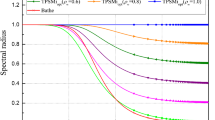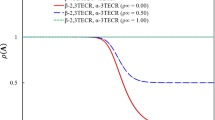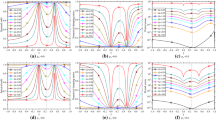Abstract
This paper strictly focuses upon novel designs of the time-integration algorithms as applied to structural dynamics systems with or without physical damping. The significant advances and contributions are summarized as follows: (1) the identity between the composite time-integration algorithms and the diagonally implicit Runge–Kutta family of algorithms are specifically established and demonstrated in order to clarify the originality, development, contribution, and pros/cons of the composite time-integration algorithms developed over the recent decades; (2) then, it is pointed out that the design of potential next-generation multi-stage time-integration algorithms with improved numerical properties can directly emanate from and already exist within the diagonally implicit Runge–Kutta–Nyström (DIRKN) computational framework itself, unlike composite-type time-integration methods paying efforts and attempting to design new algorithmic structures, although they are identical to and pertain primarily to the existing RK-type variants; (3) one- and two-stage DIRKN family of new algorithms and novel designs are taken into consideration for the first time, leading to novel sets of parameters with different numerical properties, which not only encompass existing methods by assigning two identical principal roots, but also produce new and novel designs by employing altogether distinctive principal roots; and finally, (4) the much coveted BN-stability feature and condition are additionally achieved and taken into consideration in order to optimize the design of parameters, which is competitive for nonlinear structural dynamics. Numerical examples are demonstrated to validate the analysis, new designs and the proposed overall efforts.




















Similar content being viewed by others
Data availability
The datasets generated are available from the corresponding author on reasonable request after the publication.
References
Alexander, R.: Diagonally implicit Runge–Kutta methods for stiff ODE’s. SIAM J. Numer. Anal. 14(6), 1006–1021 (1977)
Bank, R.E., Coughran, W.M., Fichtner, W., Grosse, E.H., Rose, D.J., Smith, R.K.: Transient simulation of silicon devices and circuits. IEEE Trans. Comput. Aided Des. Integr. Circuits Syst. 4(4), 436–451 (1985)
Bathe, K.J.: Finite Element Procedures. Klaus–Jurgen Bathe (2006)
Bathe, K.J.: Conserving energy and momentum in nonlinear dynamics: a simple implicit time integration scheme. Comput. Struct. 85(7–8), 437–445 (2007)
Bathe, K.J., Baig, M.M.I.: On a composite implicit time integration procedure for nonlinear dynamics. Comput. Struct. 83(31–32), 2513–2524 (2005)
Borri, M., Bottasso, C.: A general framework for interpreting time finite element formulations. Comput. Mech. 13(3), 133–142 (1993)
Bukač, M., Fu, G., Seboldt, A., Trenchea, C.: Time-adaptive partitioned method for fluid-structure interaction problems with thick structures. J. Comput. Phys. 473, 111708 (2023)
Bukač, M., Trenchea, C.: Adaptive, second-order, unconditionally stable partitioned method for fluid-structure interaction. Comput. Methods Appl. Mech. Eng. 393, 114847 (2022)
Burrage, K., Butcher, J.C.: Stability criteria for implicit Runge–Kutta methods. SIAM J. Numer. Anal. 16(1), 46–57 (1979)
Cannarozzi, M., Mancuso, M.: Formulation and analysis of variational methods for time integration of linear elastodynamics. Comput. Methods Appl. Mech. Eng. 127(1–4), 241–257 (1995)
Chawla, M., Sharma, S.: Families of three-stage third order Runge–Kutta–Nyström methods for \(y^{\prime \prime }= f(x, y, y^{\prime })\). ANZIAM J. 26(3), 375–386 (1985)
Choi, B., Bathe, K.J., Noh, G.: Time splitting ratio in the \(\rho _{\infty }\)-Bathe time integration method for higher-order accuracy in structural dynamics and heat transfer. Comput. Struct. 270, 106814 (2022)
Chung, J., Lee, J.M.: A new family of explicit time integration methods for linear and non-linear structural dynamics. Int. J. Numer. Methods Eng. 37(23), 3961–3976 (1994)
Crouzeix, M.: Sur l’approximation des équations différentielles opérationnelles linéaires par des méthodes de Runge-Kutta. Ph.D. thesis, Université de Paris VI Thèse (1975)
Crouzeix, M.: Sur les méthodes de runge kutta pour l’approximation des problemes d’évolution. In: Computing Methods in Applied Sciences and Engineering: Second International Symposium December 15–19, 1975, pp. 206–223. Springer, Berlin (1976)
Fine, J.M.: Low order practical Runge–Kutta–Nyström methods. Computing 38(4), 281–297 (1987)
Franco, J.: Runge–Kutta–Nyström methods adapted to the numerical integration of perturbed oscillators. Comput. Phys. Commun. 147(3), 770–787 (2002)
Geng, S.: Construction of high order symplectic Runge–Kutta methods. J. Comput. Math. 66, 250–260 (1993)
Hairer, E.: Highest possible order of algebraically stable diagonally implicit Runge–Kutta methods. BIT Numer. Math. 20(2), 254–256 (1980)
Hairer, E., Wanner, G., Nørsett, S.P.: Solving Ordinary Differential Equations I: Nonstiff Problems. Springer, Berlin (1993)
Har, J., Tamma, K.: Advances in Computational Dynamics of Particles, Materials and Structures. Wiley, New York (2012)
Hulbert, G.M.: Time finite element methods for structural dynamics. Int. J. Numer. Methods Eng. 33(2), 307–331 (1992)
Ji, Y., Xing, Y., Wiercigroch, M.: An unconditionally stable time integration method with controllable dissipation for second-order nonlinear dynamics. Nonlinear Dyn. 105(4), 3341–3358 (2021)
Kennedy, C.A., Carpenter, M.H.: Diagonally implicit Runge–Kutta methods for ordinary differential equations: a review. Tech. rep. (2016)
Kennedy, C.A., Carpenter, M.H.: Diagonally implicit Runge–Kutta methods for stiff ODEs. Appl. Numer. Math. 146, 221–244 (2019)
Kim, W.: An accurate two-stage explicit time integration scheme for structural dynamics and various dynamic problems. Int. J. Numer. Methods Eng. 120(1), 1–28 (2019)
Kim, W.: An improved implicit method with dissipation control capability: the simple generalized composite time integration algorithm. Appl. Math. Model. 81, 910–930 (2020)
Kim, W., Choi, S.Y.: An improved implicit time integration algorithm: the generalized composite time integration algorithm. Comput. Struct. 196, 341–354 (2018)
Kim, W., Lee, J.H.: An improved explicit time integration method for linear and nonlinear structural dynamics. Comput. Struct. 206, 42–53 (2018)
Kim, W., Reddy, J.: An improved time integration algorithm: a collocation time finite element approach. Int. J. Struct. Stab. Dyn. 17(02), 1750024 (2017)
Kim, W., Reddy, J.: A critical assessment of two-stage composite time integration schemes with a unified set of time approximations. Latin Am. J. Solids Struct. 18, 66 (2021)
Li, J., Yu, K.: An alternative to the Bathe algorithm. Appl. Math. Model. 69, 255–272 (2019)
Li, J., Yu, K.: Development of composite sub-step explicit dissipative algorithms with truly self-starting property. Nonlinear Dyn. 103(2), 1911–1936 (2021)
Li, J., Zhao, R., Yu, K., Li, X.: Directly self-starting higher-order implicit integration algorithms with flexible dissipation control for structural dynamics. Comput. Methods Appl. Mech. Eng. 389, 114274 (2022)
Maxam, D.J., Tamma, K.K.: Load aliasing—a new additional test concept for effective control of nonhomogeneous high-frequency behavior in linear multistep methods. Int. J. Numer. Methods Eng. 123(12), 2705–2737 (2022)
Noh, G., Bathe, K.J.: The Bathe time integration method with controllable spectral radius: the \(\rho _{\infty }\)-Bathe method. Comput. Struct. 212, 299–310 (2019)
Sanz-Serna, J., Abia, L.: Order conditions for canonical Runge–Kutta schemes. SIAM J. Numer. Anal. 28(4), 1081–1096 (1991)
Verhulst, F.: Nonlinear Differential Equations and Dynamical Systems, first. Universitext, 1st edn. Springer, Berlin (1985)
Wang, Y., Tamma, K.K., Maxam, D., Xue, T., Qin, G.: An overview of high-order implicit algorithms for first-/second-order systems and novel explicit algorithm designs for first-order system representations. Arch. Comput. Methods Eng. 28, 3593–3619 (2021)
Wang, Y., Xie, N., Yin, L., Lin, X., Zhang, T., Zhang, X., Mei, S., Xue, X., Tamma, K.: A truly self-starting composite isochronous integration analysis framework for first/second-order transient systems. Comput. Struct. 274, 106901 (2023)
Wang, Y., Xie, N., Yin, L., Zhang, T., Zhang, X., Mei, S., Xue, X., Tamma, K.: On the application of the GS4-1 framework for fluid dynamics and adaptive time-stepping via a universal A-posteriori error estimator. Int. J. Numer. Methods Heat Fluid Flow 32(10), 3306–3327 (2022)
Wang, Y., Xue, T., Tamma, K.K., Maxam, D., Qin, G.: An accurate and simple universal a posteriori error estimator for GS4-1 framework: adaptive time stepping in first-order transient systems. Comput. Methods Appl. Mech. Eng. 374, 113604 (2021)
Wang, Y., Xue, X., Zhang, T., Dai, Q., Liu, Y., Xie, N., Mei, S., Zhang, X., Tamma, K.K.: Overview and novel insights into implicit/explicit composite time integration type methods—fall under the RK: no ifs, ands, or buts. Arch. Comput. Methods Eng. 30, 3891–3940 (2023)
Wang, Y., Zhang, T., Zhang, X., Mei, S., Xie, N., Xue, X., Tamma, K.: On an accurate A-posteriori error estimator and adaptive time stepping for the implicit and explicit composite time integration algorithms. Comput. Struct. 266, 106789 (2022)
Wanner, G., Hairer, E.: Solving Ordinary Differential Equations II: Stiff and Differential-algebraic Problems. Springer, Berlin (1996)
Zhang, H., Xing, Y.: Two novel explicit time integration methods based on displacement-velocity relations for structural dynamics. Comput. Struct. 221, 127–141 (2019)
Zhou, X., Tamma, K.K.: Design, analysis, and synthesis of generalized single step single solve and optimal algorithms for structural dynamicsD. Int. J. Numer. Methods Eng. 59(5), 597–668 (2004)
Zhou, X., Tamma, K.K.: Algorithms by design with illustrations to solid and structural mechanics/dynamics. Int. J. Numer. Methods Eng. 66(11), 1738–1790 (2006)
Funding
This work is supported by The Science and Technology Project of China Three Gorges Corporation (Grant No. 202103404) and the project of Power Construction Corporation of China (No. DJ-HXGG-2022-05).
Author information
Authors and Affiliations
Contributions
All authors contributed to the study conception and design. Material preparation, data collection and analysis were performed by YW, XX, HZ and KT. The first draft of the manuscript was written by Yazhou Wang, and all authors commented on previous versions of the manuscript. All authors read and approved the final manuscript.
Corresponding authors
Ethics declarations
Conflict of interest
The authors have no relevant financial or non-financial interests to disclose.
Additional information
Publisher's Note
Springer Nature remains neutral with regard to jurisdictional claims in published maps and institutional affiliations.
Appendices
Appendices
Appendix A: Mathematical formulation in the two-stage DIRKN method
The components of the amplification matrix in the proposed two-stage DIRKN method are written as Eq. (A.1), and the local error is written as Eq. (A.2).
where \(D = \left( \overline{a}_{11}\varOmega ^2 + 2\xi a_{11}\varOmega + 1\right) \left( \overline{a}_{22}\varOmega ^2 + 2\xi a_{22}\varOmega \right. \left. + 1\right) \).
Rights and permissions
Springer Nature or its licensor (e.g. a society or other partner) holds exclusive rights to this article under a publishing agreement with the author(s) or other rightsholder(s); author self-archiving of the accepted manuscript version of this article is solely governed by the terms of such publishing agreement and applicable law.
About this article
Cite this article
Wang, Y., Xue, X., Wang, T. et al. The generalization of diagonally implicit Runge–Kutta–Nyström method with controllable numerical dissipation for structural dynamics. Nonlinear Dyn 112, 525–559 (2024). https://doi.org/10.1007/s11071-023-09065-7
Received:
Accepted:
Published:
Issue Date:
DOI: https://doi.org/10.1007/s11071-023-09065-7




